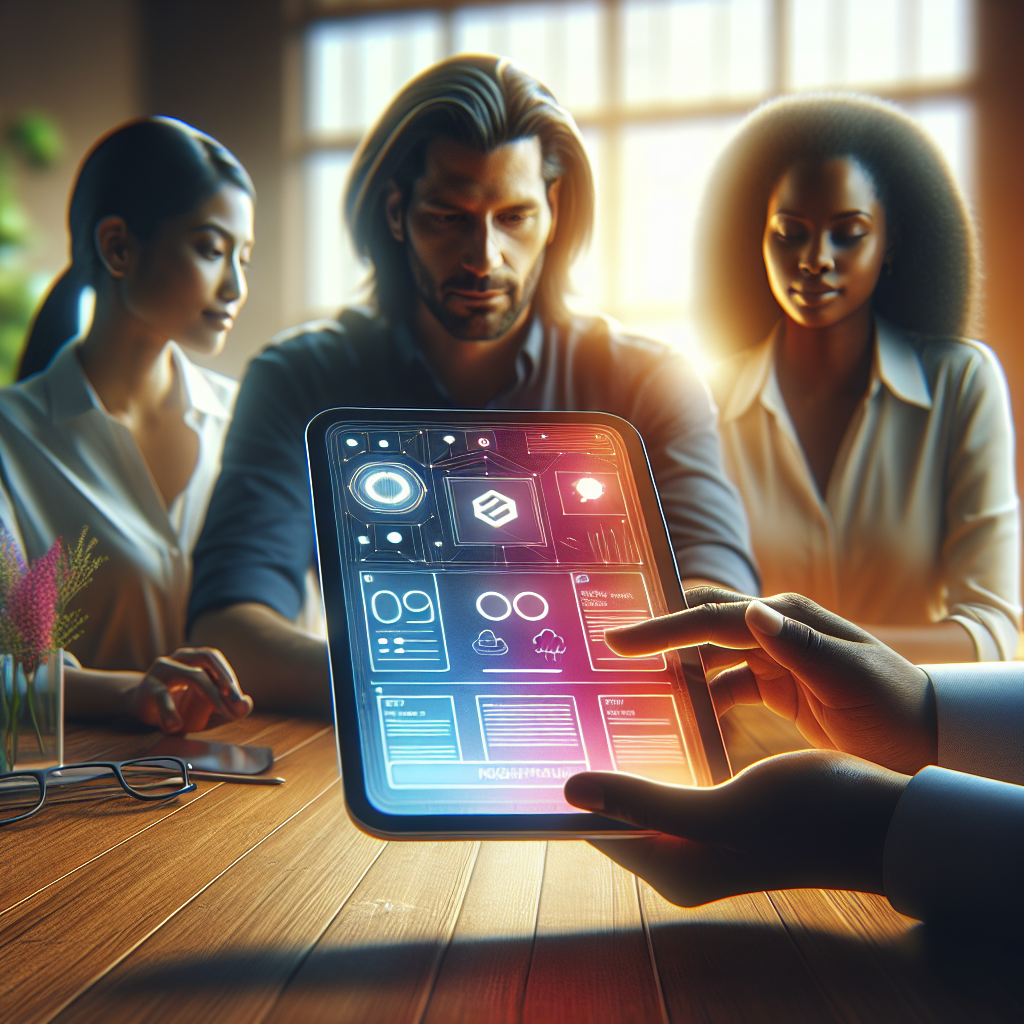Creating a mobile app prototype is a crucial step in the app development process. **_Understanding the importance of mobile app prototypes_** can significantly enhance the chances of your app’s success. Prototypes serve as a preliminary version of your app, allowing you to visualize and test your ideas before investing time and resources into full-scale development.
One primary benefit of developing a prototype is that it facilitates early feedback. By presenting a working model of your app to potential users or stakeholders, you can gather valuable insights that help refine your concept. This iterative process ensures that your app aligns with user expectations and preferences.
Moreover, prototypes can help identify potential issues in the user interface and overall user experience. By simulating the app’s functionality, you can assess how intuitive and user-friendly it is. This early detection of flaws can save significant costs later in the development cycle.
In addition, prototypes play a vital role in securing funding or support for your project. Investors are more likely to support a concept that they can see in action, rather than just a written proposal. A clear and functional prototype can make your pitch much more compelling.
Ultimately, incorporating a mobile app prototype into your development strategy leads to a more efficient, user-centered design process. If you’re wondering how to make a mobile app prototype, consider seeking guidance from experts in the field.
Tools and Software for Mobile App Prototyping

When embarking on the journey of creating a mobile app prototype, choosing the right tools and software for mobile app prototyping is essential. There are numerous platforms available, each offering unique features tailored to different aspects of the prototyping process.
Some of the most popular tools include:
- Adobe XD: Known for its user-friendly interface, Adobe XD allows designers to create high-fidelity prototypes with ease. It supports collaboration and feedback, making it ideal for teams.
- Figma: A browser-based design tool that promotes real-time collaboration. Figma is particularly beneficial for teams working remotely, as multiple users can edit the prototype simultaneously.
- InVision: This tool focuses on creating interactive prototypes that can be easily shared and tested. InVision excels in its ability to integrate user feedback directly into the design process.
- Axure RP: A powerful tool for creating complex prototypes with advanced interactions. Axure is preferred by professionals who need detailed functionality in their prototypes.
- Sketch: Widely used among designers, Sketch is great for designing user interfaces and has a robust plugin ecosystem that enhances its prototyping capabilities.
Each of these tools has unique strengths, and the choice largely depends on your specific project needs, team size, and budget. As you explore these options, consider factors such as ease of use, collaboration features, and the level of fidelity required for your prototype.
Step-by-Step Process to Create a Mobile App Prototype
Creating a mobile app prototype can be a structured process that streamlines your app development journey. Here’s a step-by-step process to create a mobile app prototype that ensures you cover all essential aspects:
- Define Your Goals: Begin by outlining the primary objectives of your app. Understand the problems it aims to solve and the target audience it will serve.
- Conduct Market Research: Analyze competitors and gather insights into user preferences. This will help you identify key features and functionalities that resonate with your audience.
- Sketch Your Ideas: Use paper and pencil to create rough sketches of your app’s layout and design. This stage is crucial for visualizing your ideas without getting bogged down by technicalities.
- Choose Prototyping Tools: Select the right software or tools based on your needs. Consider factors such as ease of use, collaboration options, and the level of detail required.
- Create the Wireframe: A wireframe serves as the skeletal framework of your app. Focus on the layout, navigation, and user flow, ensuring that all elements align with your defined goals.
- Develop Interactive Elements: Once the wireframe is ready, add interactive elements to simulate the user experience. This includes buttons, links, and transitions that enhance usability.
- Gather Feedback: Share your prototype with potential users and stakeholders. Collect feedback to identify areas of improvement and adjust your design accordingly.
- Refine and Iterate: Based on the feedback received, make necessary adjustments to your prototype. This iterative process is key to developing a user-friendly app.
- Prepare for Development: Once satisfied with the prototype, document all specifications and hand them off to your development team to start the coding process.
By following this structured approach, you can ensure that your mobile app prototype is not only visually appealing but also functional and aligned with user expectations.
Best Practices for Designing Mobile App Prototypes

Designing an effective mobile app prototype requires a blend of creativity and strategic thinking. Implementing best practices for designing mobile app prototypes can significantly enhance the user experience and streamline the development process. Here are some essential practices to consider:
- Prioritize User-Centered Design: Always keep the end-user in mind. Conduct user research to understand their needs, preferences, and pain points. This will help you create a prototype that resonates with your audience.
- Maintain Consistency: Ensure that design elements such as colors, fonts, and button styles are consistent throughout the prototype. This not only enhances aesthetics but also improves user navigation.
- Focus on Usability: Strive for a simple and intuitive user interface. Avoid clutter and unnecessary features that may confuse users. Use recognizable icons and standard navigation patterns to facilitate ease of use.
- Incorporate Feedback Loops: Regularly solicit feedback from users and stakeholders at various stages of the prototyping process. This iterative approach allows for continuous improvement and helps identify usability issues early on.
- Utilize High-Fidelity Prototypes: While low-fidelity sketches are useful for initial brainstorming, high-fidelity prototypes provide a more realistic representation of the final product. This can lead to more effective testing and feedback.
- Test on Real Devices: Whenever possible, test your prototype on actual devices. This helps identify potential issues related to screen size, touch responsiveness, and overall user experience.
- Document Design Guidelines: Create a comprehensive style guide that outlines design elements and specifications. This will ensure consistency when transitioning from the prototype to the development phase.
By adhering to these best practices, you can create a mobile app prototype that not only meets user needs but also facilitates a smoother transition into the development phase.
Testing and Feedback on Your Mobile App Prototype

Testing and gathering feedback are critical components of the mobile app prototyping process. This stage not only validates your design but also uncovers potential issues before further development. Here’s how to effectively conduct testing and feedback on your mobile app prototype:
- Define Testing Objectives: Clearly outline what you aim to achieve through testing. This could include assessing usability, identifying bugs, or gathering user impressions. Having specific objectives will guide your testing process.
- Choose the Right Testing Method: Depending on your prototype’s fidelity, select appropriate testing methods. For low-fidelity prototypes, consider qualitative methods like user interviews or focus groups. For high-fidelity prototypes, usability testing sessions can provide quantitative data.
- Recruit Target Users: Involve real users who match your target audience. Their insights will be more relevant and can help you understand how your app will be received in the market.
- Conduct Usability Tests: During usability tests, observe users as they interact with your prototype. Pay close attention to their behavior and any difficulties they encounter. This can provide invaluable insights into user experience.
- Gather Feedback: After testing, engage users in a feedback session. Ask open-ended questions to encourage detailed responses. Utilize surveys or questionnaires to gather structured feedback, focusing on aspects such as ease of use, design appeal, and functionality.
- Analyze Results: Compile and analyze the feedback to identify patterns and common issues. Prioritize problems based on their impact on user experience and feasibility of resolution.
- Iterate and Improve: Use the insights gained to refine your prototype. Make necessary adjustments, and consider conducting additional rounds of testing to validate changes.
Incorporating thorough testing and feedback into your prototyping process not only enhances the quality of your mobile app but also aligns it more closely with user expectations, ultimately leading to a more successful launch.
Finalizing Your Mobile App Prototype for Development

After completing the testing and feedback phase, the next critical step is to finalize your mobile app prototype for development. This phase involves integrating all the insights gathered and preparing your app for the actual build. Here’s how to ensure your prototype transitions smoothly into the development stage:
- Incorporate Feedback: Review all the feedback collected during testing. Identify key areas for improvement and ensure these changes are reflected in your final prototype. This not only enhances usability but also aligns the app closer to user expectations.
- Refine Design Elements: Ensure that all design elements are polished and consistent. Pay attention to colors, fonts, and navigation flows. A well-designed prototype will not only look appealing but also function intuitively.
- Document Specifications: Create comprehensive documentation that outlines every aspect of the prototype. Include features, user flows, and any technical requirements needed for developers. Clear documentation helps to minimize misunderstandings during the development phase.
- Prepare for Handoff: Organize all design assets, including graphics, icons, and style guides, for easy access by the development team. A well-prepared handoff will facilitate a smoother transition from design to development.
- Set Clear Milestones: Establish a timeline and set milestones for the development phase. This will help keep the project on track and ensure timely delivery.
- Communicate with Developers: Maintain open lines of communication with the development team. Regular check-ins can help address any questions or issues that arise during the development process.
Finalizing your mobile app prototype is a crucial step that lays the groundwork for successful development. By ensuring every detail is meticulously prepared, you set your app up for a successful launch. If you need assistance in this final phase or want to explore more about the app development journey, Book A Consultation Now!
